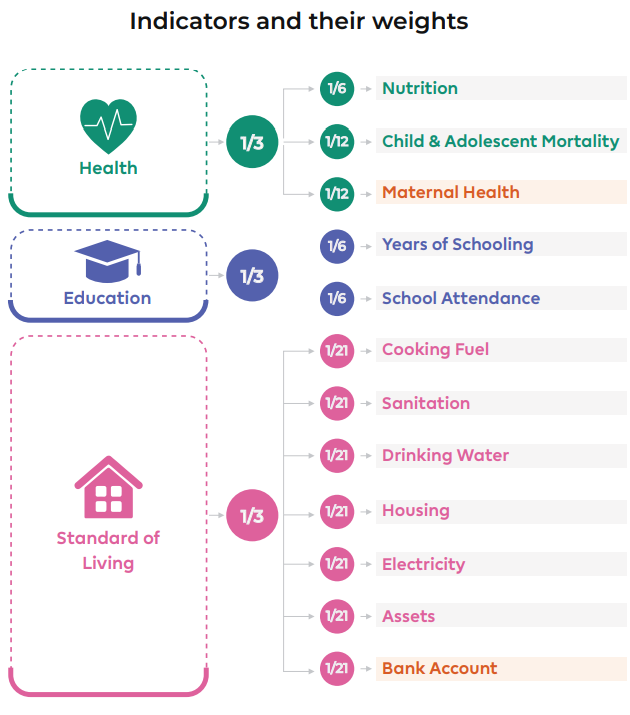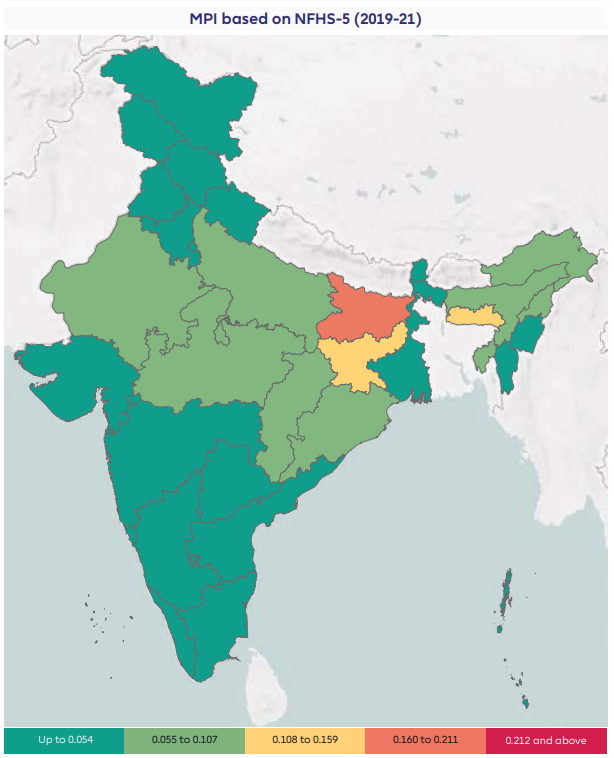Poverty alleviation in India
2023 JUL 19
Mains >
Social justice > Poverty and Hunger > Poverty allieviation
IN NEWS:
- According to the ‘National Multidimensional Poverty Index: A Progress Review 2023’, India has registered a decline in the number of “multidimensionally poor” individuals, from 24.85 % in 2015-16 to 14.96 % in 2019-2021.
NATIONAL MULTIDIMENSIONAL POVERTY INDEX:
- India’s National MPI Report underlines the Government’s commitment to understanding, measuring, and addressing the many dimensions of poverty and leveraging this understanding as a key tool in policymaking
- This is the second edition of NITI Aayog’s report on the Multidimensional Poverty Index (MPI).
- Under the three broad indicators of health, education and living standards, NITI Aayog assigns specific dimensions – such as nutrition and child adolescent mortality under health, years of schooling under education, and access to cooking fuel, electricity, bank accounts etc. under quality of living.
- Each of these specific parameters are assigned a value to calculate a ‘deprivation score’.

FINDINGS OF THE REPORT:
- The primary data source to arrive at these figures was National Family Health Survey-5 (NFHS-5).
- In absolute terms, approximately 13.5 crore Indians escaped poverty between the five-year time period, courtesy of improvements in indicators like access to cooking fuel, sanitation, drinking water, and bank accounts, among others.
- However, the report showed that when it came to indicators like nutrition and access to education, the improvement has only been marginal, as these parameters contributed the most in keeping one in seven Indians multidimensionally poor.


REASONS FOR PERSISTENCE OF POVERTY IN INDIA:
- The strain of a large population:
- India is projected to surpass China as the world’s most populous country in 2023, according to the United Nations’ World Population Prospects, 2022. This pressure of a large population proves a hindrance in the way of economic development and, thereby, the fight against poverty.
- Rural urban disparity:
- Disparities in multidimensional poverty still exist between rural and urban areas, with the proportion of multidimensional poor in 2019-21 being 19.28% in rural areas compared to 5.27% in urban areas.
- Under-developed economy:
- Industrially, India is a backward state. So industrial backwardness is major cause of poverty.
- For example, over the last two decades, the manufacturing sector’s proportion of GDP has remained unchanged at 17% of GDP. This is far lower than the rates in certain East Asian economies, which range from 25 to 35 per cent.
- Due to widespread bottlenecks in infrastructural facilities and slow pace of development, a large share of the population still lives in poverty.
- Increasing economic inequality:
- In spite of robust economic growth which averaged at over 7% per annum for over a decade, income inequality continues to expand, and the rate at which national poverty is diminishing is not proportionate to the growth in gross domestic product.
- India stands out as a “poor and very unequal country, with an affluent elite”, where the top 10 per cent holds 57 per cent of the total national income while the bottom 50 per cent’s share is just 13 per cent in 2021, according to the latest World Inequality Report 2022.
- The backward state of Indian agriculture:
- The Indian economy is heavily dependent on agriculture, and around 70% of the Indian population depends on farming, either directly or indirectly.
- But agriculture in the country continued to be in a backward state due to the use of primitive methods of production and fragmented small land holdings.
- As a result, labour and land productivity continue to be low in India. Consequently, most farmers live in poverty.
- Presence of large unorganised/informal sector:
- Despite witnessing rapid economic growth over the last two decades, 90% of workers in India have remained informally employed, producing about half of Gross Domestic Product (GDP).
- Since unorganised firms operate outside of the jurisdiction of corporate law, workers in these firms are assured of neither job-security nor social protection.
- Issues with anti-poverty schemes:
- While a large number of poverty alleviation programmes have been initiated, they function in silos. Also, the resources allocated to anti-poverty programmes are inadequate.
- For example, a huge surge in demand for MGNREGA works has been witnessed in pandemic times. But the government hasn’t duly allocated funding in a similar proportion.
- Rs. 73,000 crores have been allocated for the year 2021-22. It is greater than the original allocation of Rs. 61,500 crores for 2020-21. But this is 34.5% lower than the revised estimate of Rs.1,11,500 crores.
- Unemployment and under employment:
- Due to continuous rise in population, there is chronic unemployment and under employment in India.
- Improper use of Natural Resources:
- India being a part of Gondwanaland, is endowed with mineral wealth such as coal, iron, mica, aluminium etc., however, mining sector of India contributes only 2.2% to 2.5% to the GDP of the country.
- Social structure of the country:
- The social structure of India is still characterised by outdated traditions and customs like the caste system, laws of inheritance and succession. All these hampers inclusive growth in the country.
- Climatic change:
- India is already experiencing the consequences of one degree Celsius (°C) of global warming, extreme weather events like floods and droughts, etc., and rising sea levels.
- According to the report, titled ‘The Costs of Climate Change in India', India’s poverty rate may rise by 3.5 per cent in 2040 due to climate change.
MAJOR POVERTY ALLEVIATION PROGRAMMES:
I. Health:
- Mission Vatsalya:
- Formerly called the Integrated Child Protection Scheme (ICPS), Mission Vatsalya aims to:
- Secure a healthy and happy childhood for every child in India
- Foster a sensitive, supportive and synchronized ecosystem for development of children
- Assist States/UTs in delivering the mandate of the Juvenile Justice Act 2015
- Achieve the SDG goals
- Read more here: https://www.ilearncana.com/details/Mission-Vatsalya/3415
- POSHAN Abhiyaan - National Nutrition Mission
- It aims to improve nutritional outcomes among pregnant women, lactating mothers and children by reducing the level of stunting, underweight, anaemia and low birth weight by 2022.
- National Health Policy 2017:
- Aims to attain universal health coverage and deliver quality health care services to all at affordable cost.
- Features:
- Gradually increase public health expenditure to 2.5% of the GDP, with two-thirds of resources to be allocated to primary care.
- To provide a larger package of assured comprehensive primary healthcare through the ‘Health and Wellness Centers’
- Proposes development of infrastructure, free drugs, free diagnostics and free emergency and essential healthcare services in public hospitals.
- Attain targeted reduction in indicators such as mortality, fertility rates etc.
- Ayushman Bharat:
- ABY or National Health Protection Mission is a national initiative launched to achieve the vision of Universal Health Coverage.
- Comprises of two components:
- Pradhan Mantri Jan Arogya Yojana (PMJAY): It aims to reduce out of pocket expenses by providing health insurance coverage upto Rs.5 lakh/family/year for secondary and tertiary care hospitalization.
- Health and Wellness Centre: Aim to provide preventive, rehabilitative and curative care for an expanded range of services encompassing reproductive and child health services, communicable diseases, non-communicable diseases, palliative care and elderly care, oral health, ENT care, and basic emergency care.
II. Education:
- Right to Education (2002) and RTE Act, 2009:
- The 86th amendment to the constitution of India in 2002, provided Right to Education as a fundamental right in part-III of the Constitution. The same amendment inserted Article 21A which made Right to Education a fundamental right for children between 6-14 years.
- The 86th amendment provided for a follow-up legislation for Right to Education Bill 2008 and finally Right to Education Act 2009.
III. Living standards
- Integrated Rural Development Programme (IRDP):
- It was introduced in 1978-79 and universalized from 2nd October, 1980, and it aimed at providing assistance to the rural poor in the form of subsidy and bank credit for productive employment opportunities through successive plan periods.
- Jawahar Rozgar Yojana (JRY)/Jawahar Gram Samriddhi Yojana:
- The JRY was meant to generate meaningful employment opportunities for the unemployed and underemployed in rural areas through the creation of economic infrastructure and community and social assets.
- Rural Housing – Indira Awaas Yojana
- Sampoorna Gramin Rozgar Yojana (SGRY)
- Mahatma Gandhi National Rural Employment Guarantee Act (MGNREGA) 2005:
- It was launched on February 2, 2005. The Act provides 100 days assured employment every year to every rural household. One-third of the proposed jobs would be reserved for women.
- National Food for Work Programme:
- It was launched on November 14, 2004 in 150 most backward districts of the country. Now this programme has been subsumed in the MGNREGA from February 2, 2006.
- National Rural Livelihood Mission: Ajeevika (2011)
- It is the skill and placement initiative of Ministry of Rural development. It is a part of National Rural Livelihood Mission (NRLM)–the mission for poverty reduction is called Ajeevika.
- Pradhan Mantri Kaushal Vikas Yojna:
- The cabinet on March 21, 2015 cleared the scheme to provide skill training to 1.4 million youth with an overall outlay of Rs. 1120 crore.
- Pradhan Mantri Jan Dhan Yojana
WAY FORWARD:
- Inclusive growth:
- Inclusive growth is perceived as a necessary condition for reducing poverty with a long-term perspective that is broad based and incorporating the divergent actors.
- Increase in Employment:
- Special measures should be taken to solve the problems of unemployment and disguised unemployment.
- Agriculture should be developed. Small scale and cottage industries should be developed in rural areas to generate employment.
- Problem of Distribution:
- The public distribution system (PDS) should be strengthened to remove poverty. Poor section should get food grains at subsidized rates and in ample quantity.
- Stability in Price Level:
- Stability in prices helps to remove poverty. If prices continue to rise, the poor will become poorer. So Government should do it best to keep the prices under control.
- Fulfilment of minimum needs of the Poor:
- Govt. should take suitable steps to meet minimum needs of the poor e.g., supply of drinking water and provision of primary health centres and primary education.
- Population Control:
- Population in India has been increasing. For removal of poverty the growth rate of population should be lowered.
- Equal distribution of Income:
- Mere increase in production and control on population growth will not remove poverty in India. It is necessary that inequality in the distribution of income should be reduced.
CONCLUSION:
- With Covid-19 receding and, hopefully, with Russia-Ukraine War coming to an amicable end soon, India needs to chalk out her future strategy of growth.
- The broad objective must be to raise the per capita income, estimated in 2022-23 at $USD 2,379, by almost six times over the next 25 years. That will enable people to have a higher standard of living and eliminate poverty.
PRACTICE QUESTION:
Q. NITI Aayog's National National Multidimensional Poverty Index: A Progress Review 2023 underlines the Government’s commitment to understanding, measuring, and addressing the many dimensions of poverty and leveraging this understanding as a key tool in policymaking. Elucidate.


